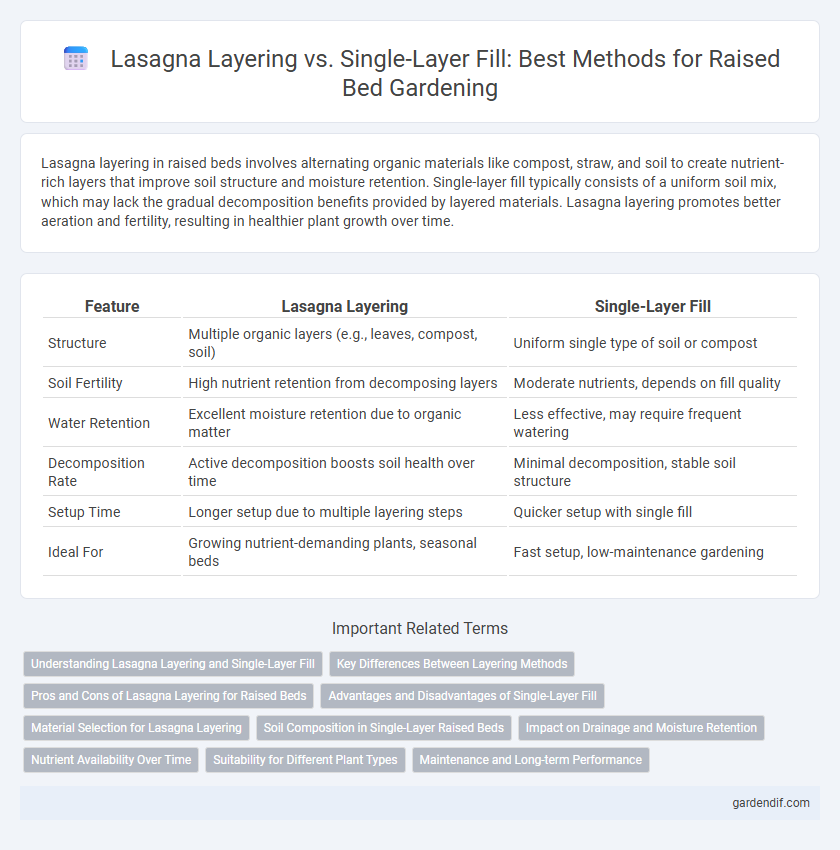
Lasagna layering vs Single-layer fill Illustration
Lasagna layering in raised beds involves alternating organic materials like compost, straw, and soil to create nutrient-rich layers that improve soil structure and moisture retention. Single-layer fill typically consists of a uniform soil mix, which may lack the gradual decomposition benefits provided by layered materials. Lasagna layering promotes better aeration and fertility, resulting in healthier plant growth over time.
Table of Comparison
| Feature | Lasagna Layering | Single-Layer Fill |
|---|---|---|
| Structure | Multiple organic layers (e.g., leaves, compost, soil) | Uniform single type of soil or compost |
| Soil Fertility | High nutrient retention from decomposing layers | Moderate nutrients, depends on fill quality |
| Water Retention | Excellent moisture retention due to organic matter | Less effective, may require frequent watering |
| Decomposition Rate | Active decomposition boosts soil health over time | Minimal decomposition, stable soil structure |
| Setup Time | Longer setup due to multiple layering steps | Quicker setup with single fill |
| Ideal For | Growing nutrient-demanding plants, seasonal beds | Fast setup, low-maintenance gardening |
Understanding Lasagna Layering and Single-Layer Fill
Lasagna layering involves stacking organic materials like cardboard, compost, and mulch in alternating layers to create nutrient-rich soil that improves moisture retention and promotes healthy root growth. Single-layer fill, typically composed of uniform soil or compost, offers a simpler setup but may lack the diverse microbial activity and long-term fertility provided by lasagna layering. Understanding these methods helps gardeners choose between immediate planting readiness with single-layer fill and the sustainable, soil-enhancing benefits of lasagna layering in raised bed gardening.
Key Differences Between Layering Methods
Lasagna layering in raised beds involves alternating organic materials such as compost, straw, and kitchen scraps to create nutrient-rich, well-drained soil, promoting faster decomposition and soil health. Single-layer fill consists of using one homogeneous soil mix throughout the bed, which simplifies setup but may require more frequent amendments to maintain fertility. Key differences include nutrient cycling efficiency, soil structure development, and maintenance frequency, with lasagna layering offering enhanced long-term soil vitality.
Pros and Cons of Lasagna Layering for Raised Beds
Lasagna layering in raised beds involves alternating organic materials like compost, leaves, and grass clippings, promoting faster decomposition and improved soil fertility compared to single-layer fill. This method enhances moisture retention and reduces the need for frequent watering but can require more labor and time to establish. However, uneven decomposition may cause soil settling, necessitating periodic top-ups to maintain optimal bed height.
Advantages and Disadvantages of Single-Layer Fill
Single-layer fill in raised beds simplifies construction and reduces material costs by using uniform soil or compost throughout. This method allows for consistent nutrient availability and easier soil management but can lead to quicker nutrient depletion and less efficient moisture retention compared to layered Lasagna techniques. Overall, single-layer fill suits gardeners seeking straightforward setup and maintenance but may require more frequent soil amendments to maintain fertility.
Material Selection for Lasagna Layering
Lasagna layering in raised beds optimizes soil health by alternating organic materials such as carbon-rich leaves and nitrogen-rich kitchen scraps, promoting balanced decomposition and nutrient release. Material selection emphasizes compostable layers including straw, grass clippings, and shredded paper, enabling improved aeration and moisture retention compared to the uniform composition of single-layer fill. This stratified approach reduces soil compaction and supports beneficial microbial activity, enhancing plant growth in raised bed gardening.
Soil Composition in Single-Layer Raised Beds
Single-layer raised beds typically feature a homogeneous soil composition, blending topsoil, compost, and organic matter to provide a nutrient-rich, aerated medium for plant roots. This uniform soil profile promotes efficient water retention and root penetration while minimizing nutrient stratification found in layered lasagna beds. Optimizing soil texture and structure in single-layer fills enhances microbial activity, supporting robust plant growth and sustainable gardening outcomes.
Impact on Drainage and Moisture Retention
Lasagna layering in raised beds enhances drainage by alternating organic materials with varying moisture-holding capacities, creating a balanced environment that prevents waterlogging while retaining adequate moisture for plant roots. In contrast, single-layer fill often compacts over time, reducing aeration and leading to poor drainage and inconsistent moisture retention. This structured layering method promotes healthier root development and reduces the risk of root rot compared to uniform soil fills.
Nutrient Availability Over Time
Lasagna layering in raised beds enhances nutrient availability over time by combining decomposing organic matter in multiple layers, creating a slow-release nutrient system that feeds plants continuously. Single-layer fill provides an initial nutrient boost but tends to deplete quickly, requiring more frequent replenishment. This dynamic makes lasagna layering an effective method for sustained soil fertility and improved plant growth throughout the growing season.
Suitability for Different Plant Types
Lasagna layering in raised beds offers enriched soil composition ideal for deep-rooted plants like tomatoes and carrots, promoting robust nutrient uptake through decomposing organic matter. Single-layer fill suits shallow-rooted crops such as lettuce and radishes by providing uniform soil depth that supports rapid growth and easier root expansion. Selecting the appropriate method enhances plant health and maximizes yield based on root system requirements.
Maintenance and Long-term Performance
Lasagna layering in raised beds enhances soil fertility and moisture retention by alternating organic materials, which reduces the need for frequent maintenance compared to single-layer fill that often requires regular nutrient replenishment. This method promotes long-term soil health through continuous decomposition and nutrient cycling, supporting robust plant growth over multiple seasons. Single-layer fills may compact over time, reducing aeration and drainage, leading to increased maintenance efforts and diminished performance.
Lasagna layering vs Single-layer fill Infographic

 gardendif.com
gardendif.com